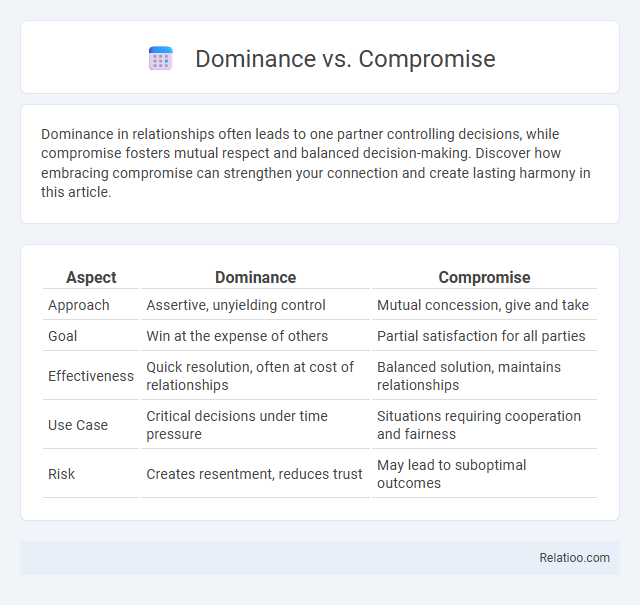Dominance in relationships often leads to one partner controlling decisions, while compromise fosters mutual respect and balanced decision-making. Discover how embracing compromise can strengthen your connection and create lasting harmony in this article.
Table of Comparison
| Aspect | Dominance | Compromise |
|---|---|---|
| Approach | Assertive, unyielding control | Mutual concession, give and take |
| Goal | Win at the expense of others | Partial satisfaction for all parties |
| Effectiveness | Quick resolution, often at cost of relationships | Balanced solution, maintains relationships |
| Use Case | Critical decisions under time pressure | Situations requiring cooperation and fairness |
| Risk | Creates resentment, reduces trust | May lead to suboptimal outcomes |
Understanding Dominance in Relationships
Dominance in relationships involves exerting control or influence over decisions, often shaping the dynamics between partners. Understanding your role in dominance helps identify when it fosters mutual respect or triggers imbalance, potentially leading to conflict. Recognizing the difference between dominance and compromise is essential for maintaining healthy communication and emotional connection.
The Psychology Behind Compromise
Compromise represents a strategic balance between dominance and submission, where individuals prioritize mutual benefits over winning conflicts. Psychological studies highlight that embracing compromise fosters emotional intelligence, enabling better conflict resolution and healthier interpersonal relationships. Understanding the drive behind compromise reveals its role in reducing stress and promoting cooperative problem-solving in social and professional settings.
Dominance: Pros and Cons
Dominance in conflict resolution emphasizes assertiveness and control, allowing you to quickly enforce decisions and maintain authority in critical situations. This style can lead to efficient problem-solving but might also cause resentment or decreased cooperation due to its confrontational nature. Understanding when to balance dominance with compromise ensures your leadership fosters both decisiveness and collaboration.
The Benefits of Healthy Compromise
Healthy compromise fosters mutual respect and collaboration, allowing both parties to achieve balanced solutions without sacrificing key interests. Your relationships and decision-making processes improve when you prioritize understanding and flexibility over dominance, reducing conflict and promoting long-term success. Embracing compromise enhances communication and trust, creating a foundation for sustainable, win-win outcomes.
Power Imbalances: Signs and Solutions
Power imbalances in dominance manifest through controlling behaviors, unilateral decision-making, and suppression of dissent, while compromise promotes balanced exchanges and mutual respect in conflict resolution. Recognizing signs such as unequal resource allocation, silenced voices, or intimidation tactics is crucial for addressing dominance-related conflicts. Implementing transparent communication, fostering inclusive environments, and setting clear boundaries serve as effective solutions to mitigate power disparities and encourage equity.
Achieving Balance: When to Stand Firm
Achieving balance between dominance and compromise requires assessing the stakes and context of each decision to determine when to stand firm or yield. Dominance involves asserting one's position firmly to maintain control or secure critical outcomes, while compromise seeks mutual agreement by blending different interests. Understanding the power dynamics and desired results enables effective navigation between these strategies for optimal conflict resolution.
Communication Strategies for Conflict Resolution
Dominance in communication prioritizes asserting Your position firmly to control outcomes, often sidelining others' perspectives. Compromise seeks balance by finding middle ground where conflicting parties make mutual concessions, fostering partial satisfaction and collaboration. Adopting clear communication strategies tailored to each approach enhances conflict resolution effectiveness by addressing power dynamics and encouraging cooperative dialogue.
The Role of Empathy in Decision-Making
Empathy plays a crucial role in decision-making by balancing dominance and compromise approaches, enabling you to understand diverse perspectives and anticipate emotional responses. Dominance-driven decisions may prioritize control over collaboration, but empathy integrates others' feelings to foster more inclusive and sustainable outcomes. Compromise thrives when empathy guides negotiations, allowing parties to find common ground while respecting individual needs and values.
Building Trust Through Mutual Respect
Building trust through mutual respect requires balancing dominance and compromise by recognizing the value each approach brings to interpersonal dynamics. Dominance establishes clear leadership and decisiveness, while compromise fosters collaborative problem-solving and equitable outcomes. Prioritizing open communication and empathy strengthens relationships, ensuring trust is built on a foundation of respect and understanding.
Creating Lasting Harmony: Integrating Dominance and Compromise
Creating lasting harmony in relationships requires balancing dominance and compromise effectively to meet both parties' needs. Your ability to recognize when to assert control versus when to yield fosters mutual respect and sustainable solutions. Integrating dominance with compromise creates a dynamic where collaboration thrives, reducing conflict and enhancing long-term connection.

Infographic: Dominance vs Compromise
 relatioo.com
relatioo.com